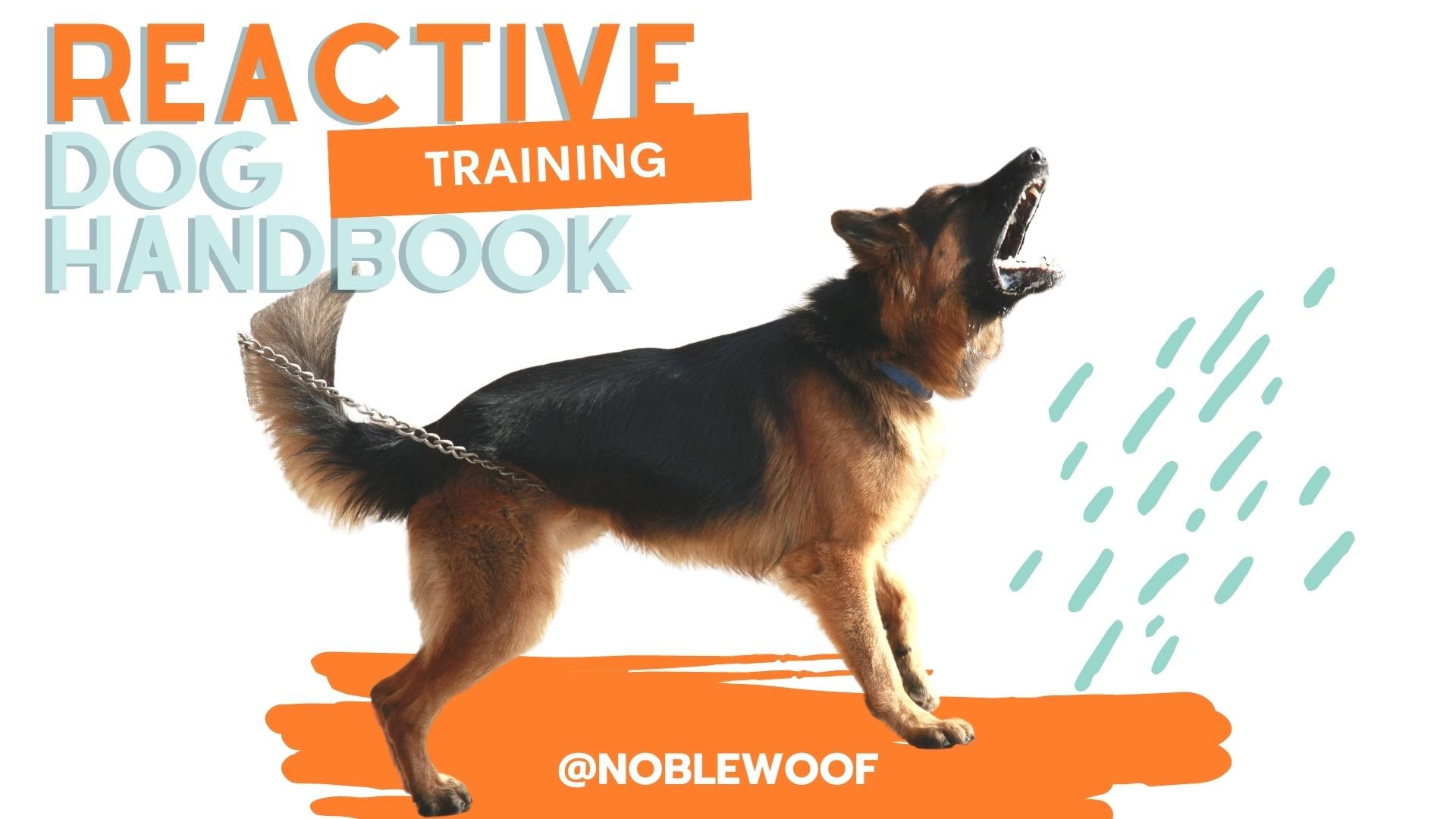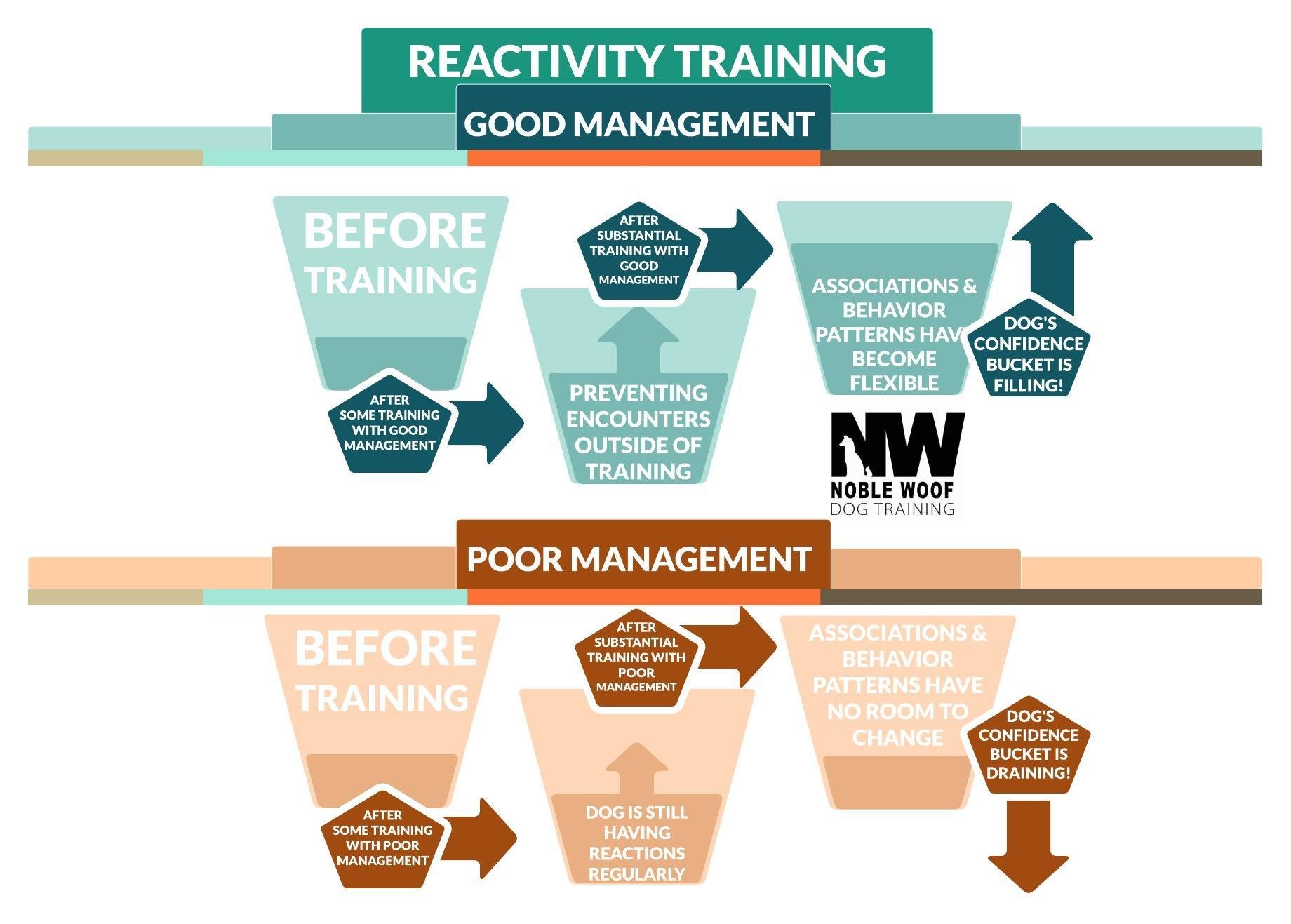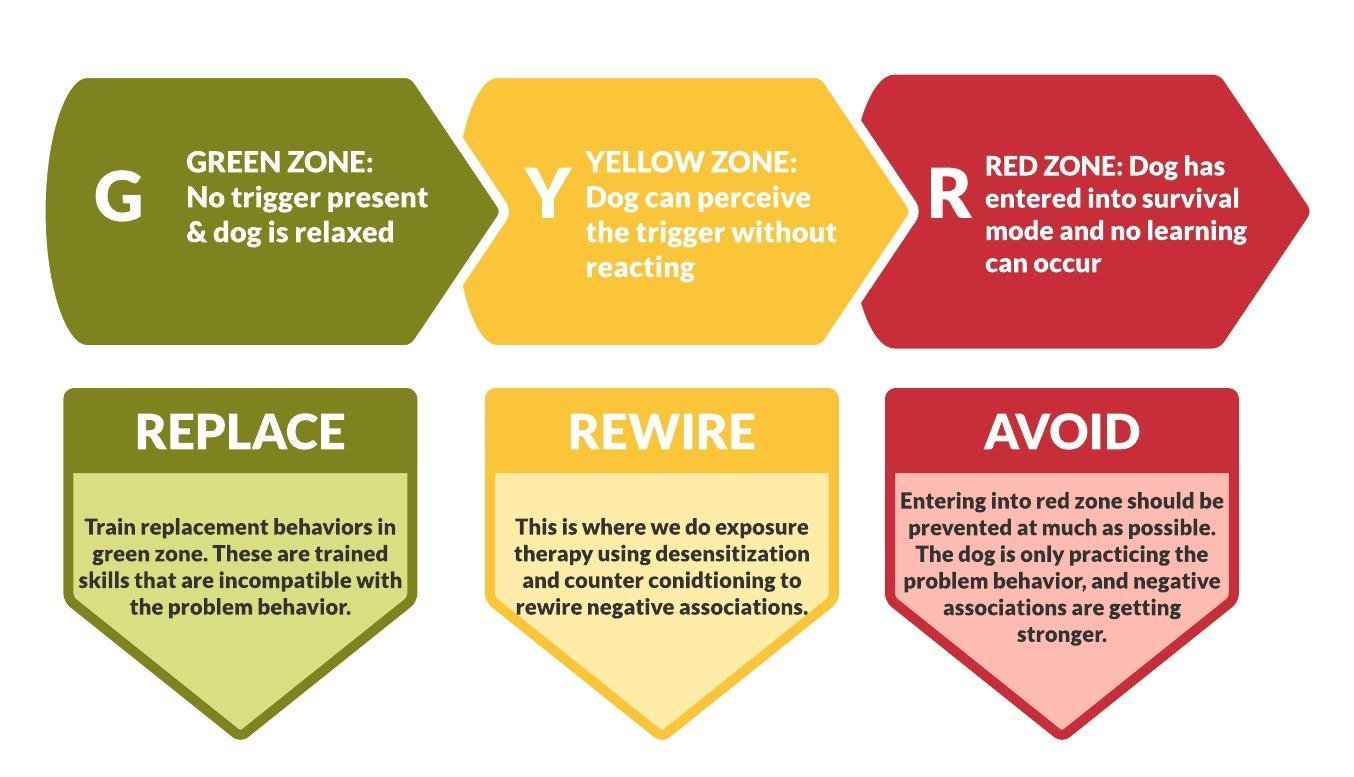Reactive Dog Training Handbook
REACTIVITY IN DOGS
Keeping Fido “under threshold”.
Brie Blakeman, CBCC-KA,CPDT-KA
─ Noble Woof Dog Training Portland, Oregon
What causes leash reactivity?
Leash reactivity is an involuntary emotional state that overwhelms the dog’s senses, and is triggered by the fight or flight center of the brain.
The loud display of a reactive dog is an irrational and reflexive symptom caused by the underlying emotions of stress, anxiety, excitement, fear or frustration. When a dog is restricted by a leash while overwhelmed with these unsavory emotions, cortisol spikes in their blood to help them escape the fearful trigger or event, but because the leash is preventing them from “flight” the dog’s only option to cope with this state of panic is to “fight”. Many leash reactive dogs are perfectly ok with other canine companions off leash.
So how do we treat leash reactivity?
In order to curb the reactions we have to treat the underlying cause of the symptom. Through proper management, counterconditioning and desensitization we can begin to rewire the dog’s negative emotional associations into positive emotional associations.
Desensitization is the process of exposing the dog to the fear inducing trigger in short and achievable bursts from a great enough distance that the dog is able to perceive the trigger without going into a reactionary state. We then use counter conditioning to pair the sight of the trigger with something the dog really loves such as a high value food reward. With desensitization and counterconditioning combined we are able to diminish the dog’s negative emotional response to the trigger and over the process of many sessions change the negative response to a positive response.
Instead of...
DOG= SCARY THING
We get…
DOG= TREATS, Ooooo YUMMY TREATS!
What’s the catch?
This all makes sense intellectually but as you’ve probably already discovered, it’s not as easy as giving your dog a treat when dogs are around. The catch is that during the training process we must strive to keep the dog “at & under threshold” at all times until the dog’s negative feelings are successfully curbed. This means making sure that the dog NEVER (as much as possible) has a reaction to their trigger. For many dogs this means they will have to be heavily managed to avoid too many encounters with other dogs (or cyclists, skateboarders, children) outside of controlled training set ups. This is where having a trainer at hand can be VERY helpful to speed along the process.
Tip 1: Prevent Continued Rehearsal
Management tools: Prevention of the problem behavior is the first step
Managing your dog’s encounters to their trigger outside of a training context can be the most difficult part of reactivity training. This is especially due to the fact that your dog still needs to get at least two 20m bouts of cardio daily, all while not coming in contact with the thing that sets them off. So, for many owners this means no longer taking your dog on walks (in the beginning). Getting your dog the exercise he/she needs will require flexibility on your part and a great deal of brainstorming and creativity. Luckily, walks don’t actually count as cardio anyway. A long walk is a lot more like reading a good book than running on a treadmill.
If your dog is getting the opportunity to practice barking and lunging at other dogs 80% of the time, and is only learning how not to react 20% of the time, then they will still likely choose barking and lunging as their primary tool. However, if we greatly control their environment in the initial training phases so that they are only experiencing triggers in a training context, we can switch those percentages around to practicing good behaviors 80% of the time, and only reacting 20% of the time. This will speed along the process.
Below are some ideas on how you can get your dog physical exercise & mental enrichment outside of walks:
Visit Sniffspots instead of walks (Private & rentable acreage for dogs)
Teach your dog new skills and tricks (this will tired them out mentally)
Play Fetch in the backyard
Fetch up and down stairs inside
Use a flirt pole (giant cat toy made for dogs)
Play Tug of war
If you MUST go on walks, try walk at low traffic times of day (last resort)
Play Backyard Agility or start Doggy Parkour
Teach your dog nose work games
Use enrichment puzzle toys to feed: SEE OUR LIST
Go on off leash hikes if your dog is reliable off leash, and has a positive off leash history with other dogs
Tip 2: How to start the training process
Use Counterconditioning and Desensitization
Desensitization & CounterConditioning is the process of turning a negative stimulus/trigger into a tolerable/positive one.
Before you start: With all desensitization & CounterConditioning be sure to move at your dogs pace and practice over many short sessions spread out over the course of weeks to months. Desensitization and counterconditioning exercises help your dog form positive associations with novel stimuli such as objects, sights, sounds, and experiences.
Signs of stress/fear include yawning, full body shake off, backing away, freezing, wide eyes, whale eye, lip licking, tail tucking and growling. If you are seeing any of these signs, go back a few steps in the training until you no longer see those signs and build up again slowly.
We recommend using the Engage and Disengage game to help your adult dog or puppy form positive associations with a trigger or stimulus they find frightening.
This infographic by Grisha Stewart is very helpful.
The Engage and Disengage Game
The engage and disengage game is the tool we used to help modify the dog’s negative associations with their trigger. This is desensitization and counterconditioning part of the dog’s reactivity program. This game is the most important aspect to their training, and will teach the dog to associate the presence of their trigger with getting treats instead of feeling fearful. The added benefit of the game is that it will teach your dog to look at a dog, and instead of barking and lunging, to automatically look up to you for guidance. It helps give them a more appropriate way to deal with the stimulus, and it puts you in a position of being looked to for guidance.
Part 1) Mark and reward the dog for calm engagement with the trigger.
Part 2) Mark and reward for calm disengagement (looking back at you after looking at the trigger.)
What is “Threshold”?
The term threshold is often used in canine behavior when discussing fear, leash reactivity, and aggressive behaviors. During the actual training process when we expose our dog to their trigger, it is of utmost importance that the dog remain “at threshold” and never go over threshold.
Consider the threshold to be the front door of your house. When you open the door you are still inside your house, but looking out. When you step outside the door and close it behind you, you are in a different space. Consider your dog’s “threshold” to be a fine line moving from one mental space to another.
When our dogs are over threshold they usually exhibit behaviors that we find frustrating. Remember, they are not being “bad”, but are rather in a state of distress. Their reactions are involuntary and come from an increase in cortisol and blood pressure due to an instinctive “fight or flight” state hard wired into the dog. A dog who is over threshold is reacting in an instinctive “fight or flight” mode, rather than thinking.
Once in this state, your dog genuinely can not help it, and they also can not learn or form new associations. This is why it is our job to keep the dog “under or at threshold”, where learning can happen.
Example of The Engage & Disengage Game with an UNDER THRESHOLD Dog
Signs your dog may be over threshold:
Hard staring with inability to turn head
Whining
Barking
Lunging
Being overexcited (jumping or mouthing)
Being distracted to the point of no connection
Doing zoomies uncontrollably
Dog won’t take treats
The three zones of threshold: Green Zone, Yellow Zone, Red Zone.
Green Zone: (Under Threshold)
Body language Hints: This is where your dog is completely relaxed. They have a loose body, and relaxed face.
They can easily follow through with cues. They are excited to eat treats and they are showing Zero signs of stress. Green zones are most commonly places that they are VERY comfortable such as in their own house or backyard.
Practice “Replacement behaviors” (keep reading) often in the green zone so that they become VERY rewarding and fun for your dog. Only once your dog can offer the replacement behaviors consistently in green zone, should you begin practicing them in Yellow Zone.
Yellow Zone: (At Threshold- The Learning Zone)
Body language Hints: Yellow Zone is characterized by a slight weight shift forward, a closing of the mouth, ears perking forward, tail stiffening or upright. Possible fast twitching wags.
This is where your dog can perceive a trigger, but is still able to follow through with cues or turn their head for their marker. Their thinking brain is still on, even if they are slightly anxious or aroused by the present stimulus.
Yellow zone is the zone that counterconditioning and desensitization should happen within. Yellow zone is the zone in which learning can happen and new associations can be formed.
You are approaching red zone when...Your dog starts to have trouble turning their head away from the trigger for a treat, or they begin to whine or vocalize at all. When this starts to happen we say that the dog is getting “sticky”. It is your job to get your dog out of there quickly as they are likely to react very soon. You are too close.
TIP: If your dog is still able to turn for their marker word, and they are still able to take a treat then you are in the clear, but keep trials very short, and allow your dog time to cool off away from a trigger by going behind a visual barrier many times during a session.
Red Zone Body Language Hints: (Over Threshold)
This is when your dog really starts to react, freeze or shut down. They aren’t interested in the food you have and they can’t hear you call their name no matter how close you are to them. Avoid crossing into the red zone at all costs during training. Learning can NOT happen here. Avoid asking for any replacement behaviors when your dog is approaching “red zone”. Simply exit the situation, create a great deal of distance, and/or duck behind a visual barrier for your dog to cool off.
IMPORTANT: If you are working on fear or reactivity, going over threshold frequently will slow your dog’s progress greatly!
Tip 3: What should I do when my dog goes over threshold?
The best thing you can do for your dog when they go over threshold is to remove them from the situation. That is not the time to be practicing obedience behaviors, engage/disengage or replacement behaviors. When your dog is over threshold, he does not have full access to the part of the brain that involves thinking and problem solving (prefrontal cortex). Rather, his amygdala is fired indicating to him that he needs to fight, flight or freeze. The more space away from the scary stimulus you can create, the more your dog’s nervous system will begin to settle.
PRO TIP:
Using visual barriers in your environment to bring your dog back down under threshold is crucial! Good barriers include cars, trees or fences. If your dog goes over threshold, the only thing you can do is rapidly increase your distance from the trigger, or block the dog’s line of sight.
Once you do this, take a mental note of what happened in this situation. What distance from the trigger did your dog start to react? Be sure to stay at a greater distance next time.
Get your dog out of the situation.
Take note of all the factors that led to your dog going over threshold.
Make a plan to avoid these mistakes next time.
Things that affect your dog’s threshold:
There are many factors that come into play when our dog goes over threshold. The more we understand this, the easier it will be to understand why our dog is reacting in a certain situation. If we can diagnose the problem then we can more effectively treat it.
The number of triggers in the environment at one time (The more triggers the quicker dog enters red zone)
Proximity to a trigger (How close the trigger is)
Frequency of a trigger (How often the trigger happens)
Intensity of a trigger (A Calm dog vs. barking, lunging dog)
Hunger, Thirst, Tired or in Pain
Accumulated Stress (Family was in town for three days causing more stress to dog’s environment)
Tip 4: Train Replacement Behaviors
WHAT ARE REPLACEMENT BEHAVIORS?
Replacement behaviors are cues that we teach reactive dogs to help them stay under threshold. They are typically incompatible with the problem behavior meaning your dog can’t perform the replacement behavior while barking and lunging. Training several replacement behaviors offers dog a list of “other options” to that are incompatible to barking, lunging, and reacting. They are used to redirect their attention off a trigger, and keep them busy doing something other than reacting. Many reactive dogs simply lack confidence on leash, and these replacement behaviors are meant to build their confidence and simply help them feel more “at home” on leash.
Replacement behaviors don’t change the dog’s association with the trigger, but instead act as management tools to build confidence and to keep them from looking at the trigger.
LIST OF SOME REPLACEMENT BEHAVIORS.
Loose leash walking (The leash restricts a dogs “flight” option, so learning how to be on leash comfortably can help immensely)
Look at me (Keep attention on me instead of trigger)
Front (Reverse auto sit away from trigger facing owner)
Emergency U-Turn (Teaching an exit strategy)
Touch (Nose target to hand)
Find it (Food scatter on ground to keep attention off trigger)
Tunnel (stand between legs, rear facing trigger)
The first replacement behavior we recommend teaching is the emergency U-turn. Here is a video demonstration how to teach it.
Reactive Dog Training Video Tutorial
Are you still stuck on the no walks recommendation?
Think about this!
Did you know that taking Fido for a walk isn’t actually giving them physical exercise? For a dog, taking a walk is much more like reading a good novel than it is physical exercise. It tires out their brain but not so much their body. Additionally, if your dog is constantly going over threshold on walks, they are finding the walk to be extremely stressful, not enriching. For a reactive dog, urban walks are kinda like asking a veteran with PTSD to go watch the fireworks on the fourth of July! So, since it is best to not take your dog out on walks during these beginning stages, below are a list of ways to stimulate their minds. Many reactive dogs are very smart, thinking, worrying dogs who need to use their brains.
Ditch feeding them from a food bowl and try some of the suggestions below.
Food dispensing toys are a fantastic way to require that your dog use her brain to get to her food. Use one of these in place of a bowl.
Rubber Kongs stuffed with wet food and frozen in the freeze can provide 20-40m of entertainment for your dog.
Puzzle toys are more complicated food dispensing toys that require supervision due to small moving pieces, but are fantastic tools for reactive dogs.
Find it games around the house can teach your dog to use her nose to sniff out dinner. Sniffing for a dog is like studying for a test for us. We’re exhausted afterwards even if we were sitting at a desk the whole time.
Take a look at our TOP ENRICHMENT RECOMMENDATIONS FOR REACTIVE DOGS:
VIEW OUR ENRICHMENT TOY SHOPPING LIST
Take a look at this awesome blog article on DIY enrichment by Tails Of Connection Dog Training
THE REALITY OF REACTIVITY TRAINING
Depending on the severity of reactivity in your dog, it generally takes at least 6 months to 1 year of dedication to truly see progress. Don’t expect the training the “cure” your dogs reactivity. Think of it as a way to dial down the intensity and frequency of the reactions so that your dog is less stressed, and you feel more confident. Any trainer who promises to cure your dog of their reactivity is a fraud or are new to the field. However, with a skilled behavior modification program and the support of a Veterinary Behaviorist, even the most severe cases can be greatly reduced to the point where both dog and handler are experiencing more positive encounters than bad encounters.
A good dog trainer will be able to refer you to a qualified certified veterinary behaviorist in your area when it is needed.
Top Veterinary Behaviorist In Portland, Oregon:
The Animal Behavior Clinic
Synergy Behavior Solutions
This free blog took anywhere from 2-10 hours hours to write not including all the existing video and graphics. Graphics and video can take anywhere from 2-10 hours hours to create each. If you found this free content helpful, please consider leaving us a tip to keep programming like this coming!






